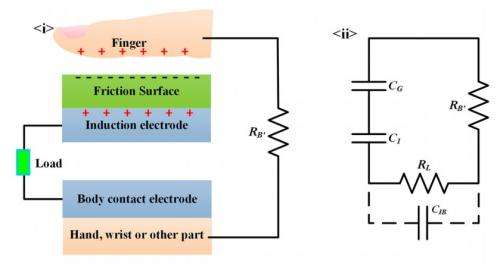March 26, 2014 feature
Generator uses the human body as an electrode to power portable electronics

(Phys.org) —It's well-known that the human body is a good conductor of electricity, and now researchers have taken advantage of this fact to create a small generator that uses the body as an electrode to power portable devices without the need for batteries. The "body contact electrode" replaces a grounded electrode that was used in a previous version of the generator, which would have been impractical for portable devices.
The researchers, Bo Meng, et al., at Peking University in Beijing, China, have published a paper on the generator using a human body electrode in a recent issue of Applied Physics Letters.
"At present, the generator is more suitable for low-power devices," coauthor Haixia Zhang, a professor at Peking University, told Phys.org. "In our future plans, we hope it can be used as a back-up power source for portable electronics."
The device's full name is a single-friction-surface triboelectric generator, or STEG. Due to the triboelectric effect, when certain materials rub against each other, they can become electrically charged. The most well-known example of the triboelectric effect is static electricity. Activities such as tapping a mobile phone with a STEG covering can also produce these electric charges. The STEG then harvests the electric charges, which can be used to power low-power electronics.
In their study, the researchers covered the front panel of a mobile phone with a flexible, transparent layer of STEG composite material. The body contact electrode—contacted with the palm of the hand or the fingers—was located on either the back side or the border of the phone to complete the electric connection.
The researchers demonstrated that patting the phone with the palm of the hand or tapping the phone with a finger causes electrons to be exchanged between human skin and the STEG material. After repeated patting/tapping, electric charge moves back and forth between the induction electrode and the charged skin.
Although researchers have a good understanding of how the triboelectric effect works, the difficulty lies in designing a generator that can achieve good performance. Somewhat surprisingly, when the researchers replaced the grounded electrode in the STEG with a human body electrode, the STEG achieved an increase in both the output current and the amount of charge transferred.
With these improvements, the STEG has potential applications for low-power portable electronics and wearable devices, which may include implanted medical devices and sensors. The researchers plan to further improve the STEG performance in the future.
"For the STEG devices, we are making efforts to improve the output of the STEG device, attempting to use new materials and fabrication methods," Zhang said. "The advantage of the human body as a good conductor will be taken to develop several novel triboelectric generator devices as well."
More information: Bo Meng, et al. "Single-friction-surface triboelectric generator with human body conduit." Applied Physics Letters 104, 103904 (2014). DOI: 10.1063/1.4868130
© 2014 Phys.org. All rights reserved.















